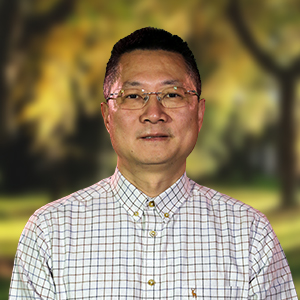Biography
Ruoli joined the School of Pharmacy as a Lecturer in Clinical Pharmacology in 2011. His background is in medicine and he completed his PhD in clinical physiology at National Heart and Lung Institute, Imperial College London in 2002. Ruoli then worked as a postdoctoral research fellow at King’s College London and University of Oxford. His research interests focus on stroke medicine, blood-brain barrier, CSF proteomics and hypoxia-inducible factors.
Research and scholarship
Research theme: Regenerative Medicine
My current research focuses on three main themes:
- Stroke medicine
- Hypoxia inducible factor (HIF) pathway
- blood brain barrier (BBB)
Current research projects are:
1. Pharmacological accumulation of HIF for neuroprotection in cerebral ischaemia
Ischaemic stroke is the leading cause of adult disability and the third biggest killer in the UK after heart attacks and cancer. Fundamental treatment for ischaemic strokes are reperfusion and neuroprotection. An approach to target entire physiological networks has been proposed to influence a number of targets at one time and thereby simultaneously supressed both ischaemic and reperfusion damage. HIF is a transcription factor that mediates essential homeostatic responses to reduced O2 availability in mammals. HIF1 has been implicated in the neuroprotection induced by hypoxia/ischaemia preconditioning in brains. A number of chemicals inhibiting prolyl hydroxylases (PHDs) can accumulate HIF in cells and could protect tissues/organs from ischaemic injury. We are going to study a number of clinical compounds that inhibit HIF PHDs for their potential neuroprotective properties in both in vitro and in vivo, collaborating with two Oxford groups (with Profs. Alastair Buchan and Chris Schofield, University of Oxford).
2. Stem cell culture in hypoxia
The process of expanding adult stem cells has been proven to be challenging not only from the bioengineering standpoint, but also from the perspective of maintaining stem cell characteristics while avoiding or delaying senescence and genetic instability. It is difficult to recapture the in vivo hypoxia environment in culture, unless maintaining the culture under a hypoxic laminar flow hood combined with a hypoxic incubator. It has been proposed that hypoxia-mimetic agents could provide a useful tool to precisely control oxygen levels in stem cell culture to maintain their native characteristics. Hypoxia-mimetic agents “artificially” induce hypoxia through blocking the degradation of HIF-1a via prolyl hydroxylase (PHD) inhibition. We are going to study some novel, selective, small molecule inhibitors of PHDs on stem cell culture to identify key gene expression and signal pathways for optimal stem cell expanding in vitro. The outcome will be informed to chemists to synthesize highly potent, more specific PHD inhibitors (with Dr Nicholas Forsyth, Keele University and Prof. Chris Schofield, University of Oxford).
3. Blood brain barrier integrity and function in ageing and in neurodegenerative diseases
Hypoxia/ischemic preconditioning is considered the next most powerful experimental neuroprotective strategy after hypothermia. HIF is of central importance in the response to hypoxia/ischaemia, and is essential for cerebral ischaemia tolerance induced by hypoxic preconditioning. Ischaemic stroke firstly affects brain endothelial cells, which form the BBB. BBB function and integrity during ischaemic stroke contribute substantially to neuropreotection and the outcomes of stroke patients. We shall investigate effects of brief exposure of BBB to hypoxia / PHD inhibition on BBB integrity and function during subsequent prolonged ischaemia (OGD). This study will identify novel therapeutic targets to prevent and treat ischaemic stroke (with Prof. Christine Roffe, Keele University and Dr Jane Preston, King’s College London).
Teaching
I teach elements of the undergraduate curriculum for the Keele University MPharm in the School of Pharmacy.
Publications
PhD Students
I welcome applications from students who wish to undertake PhD or MPhil postgraduate studies in my team. Interested students can contact me directly on r.chen@keele.ac.uk to discuss potential projects as well as searching the Keele studentship webpage for available degrees.
My current research interests are as indicated on the "Research and Scholarship" tab. Currently, we are studying a novel class of small molecule HIF prolyl hydroxylase inhibitors for neuroprotection in ischaemic stroke both in vitro and in vivo.
My team works closely with those of other investigators interested in neuroscience as part of Molecular Medicine providing a stimulating collegiate environment for postgraduate research students, regular contact with your supervisory team and access to modern research facilities.
School address:
School of Pharmacy and Bioengineering
Hornbeam Building
Keele University
Staffordshire
ST5 5BG
Research centre address:
School of Pharmacy and Bioengineering
Guy Hilton Research Centre
Thornburrow Drive
Stoke-on-Trent
ST4 7QB
Tel: +44 (0) 1782 674988
Undergraduate enquiries:
Email: enquiries@keele.ac.uk
Tel: +44 (0)1782 734010
Postgraduate enquiries:
Please contact the CPD4ALL team:
Email: phab.postgraduate@keele.ac.uk
Keele Centre for Medicines Optimisation (KCMO)
Tel: +44 (0)1782 733831 / 734131
The Virtual Patient project enquiries:
Contact our Digital Development team:
Email: pharmacy.digital@keele.ac.uk


